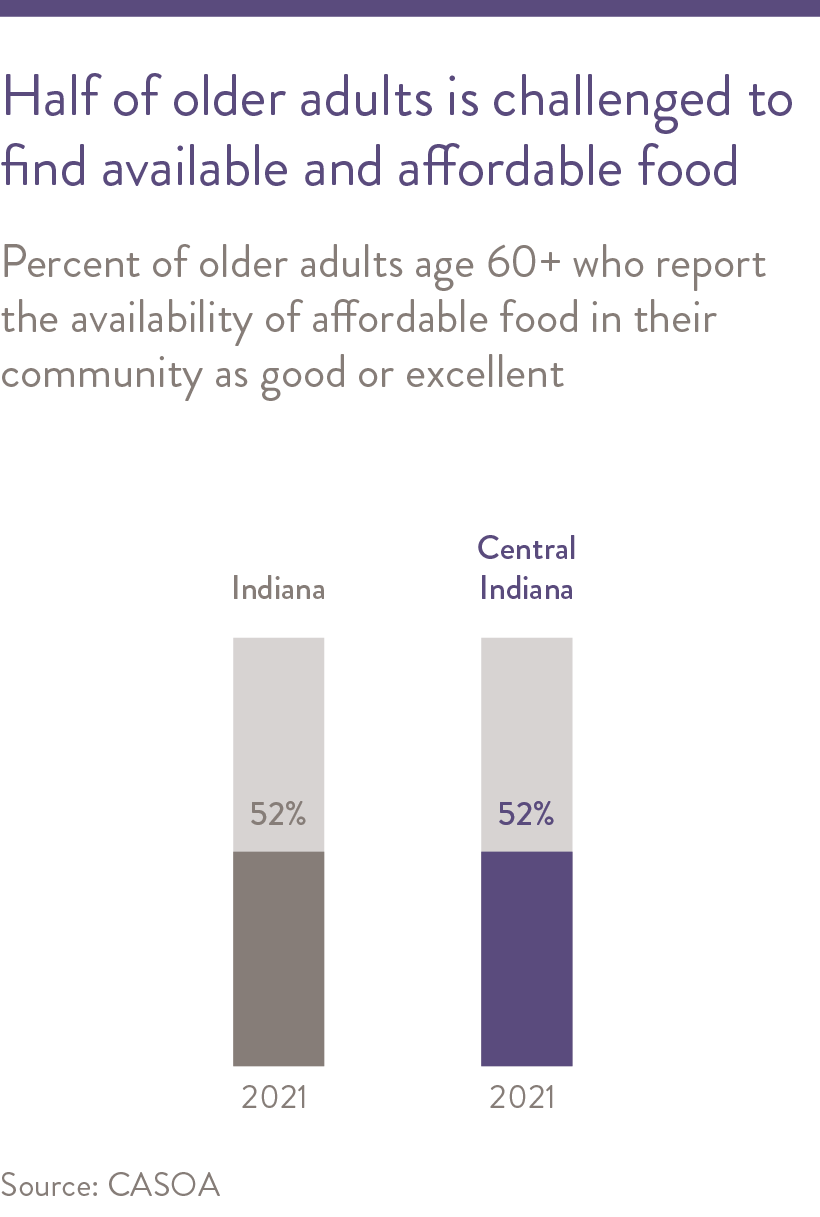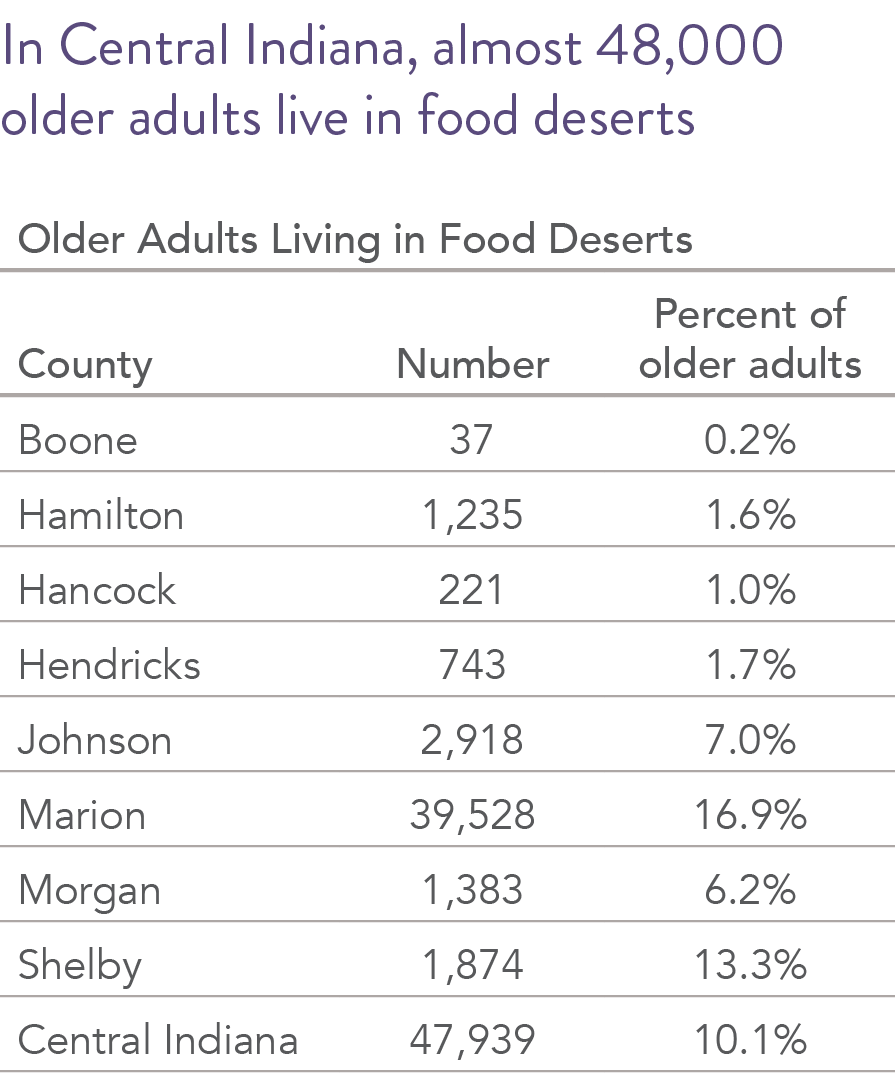Food Insecurity
Food insecurity is a challenge for many older adults with low incomes. Nationally, one in ten households are food insecure, and the rate is even higher in Indiana.
Persona
Esther and Raymond
Early 70s
Local grocery recently closed
Managing diabetes
Esther and Raymond are married Black couple living in a neighborhood on the near-northeast side of Indianapolis. Raymond is 72 years old, and Esther is 70. Both are retired. Raymond was a maintenance worker. Esther didn’t work outside the home when their children were growing up. Once they moved out, she worked as a program assistant in a nonprofit agency near her home. Esther and Raymond’s annual household income is $34,000 all of which comes from Social Security benefits. They have retirement savings of about $40,000.
Two years ago, Esther was diagnosed with diabetes and began taking medications for it. At the time, her doctor also recommended lifestyle and dietary changes to slow the progression of the disease. With Raymond’s encouragement, she began walking more and created a meal plan to incorporate more fruits and vegetables into their meals. Lately, however, financial struggles have made it difficult to stick with the plan. One of their children needed help with an unforeseen expense, and a leak in their roof needed required repairs. Then a mechanic told them that their car needs a new transmission and is currently unsafe to drive—but they are postponing the repair work until their financial situation stabilizes. To make ends meet between Social Security checks, Esther and Raymond recently visited the food pantry of a nearby church and received a week’s worth of food. It was the first time they had relied on a food pantry.
Several years ago, the chain grocery store they liked to shop at—just two blocks from their home—closed. The nearest grocery is now more than two miles away. It takes about half an hour to reach on public transit. Because of their car situation, they have begun buying food mainly at a local convenience store. The only produce it stocks are bananas and apples. Mostly, Esther and Raymond buy frozen, prepared meals. They can also get a week’s worth of food once a month from the church pantry. If their old grocery store were still open, they would walk to it and buy fresh produce. Now, they worry that the lack of access to fresh produce and other nutritious food on a regular basis is putting them on a path toward negative health outcomes.

Food insecurity is a challenge for many older adults with low incomes. Nationally, one in ten households are food insecure, and the rate is even higher in Indiana. This section of the report discusses the breadth of food insecurity among Central Indiana’s older adults, including food access and barriers to food security. Key findings include:
- 12.9 percent of Central Indiana residents age 50-59 were food insecure in 2020. This remained steady even as the national rate declined since 2018. 8.6 percent of Central Indiana residents age 60 and older were food insecure in 2020. This declined from 9.9 percent in 2018.
- According to older adults and service providers, the chief barriers to food access and security are transportation and money.
- Ten percent of Central Indiana older adults live in a food desert. The rate is highest in Marion and Shelby Counties. There are 2,800 fewer Marion County older adults in food deserts in 2021 compared to 2020.
- The Federal Supplemental Nutrition Assistance Program (SNAP) provides necessary benefits to older adults experiencing poverty, yet only half of eligible adults age 60 and older participate in the program.
FOOD INSECURITY AND FOOD ACCESS
The U.S. Department of Agriculture (USDA) defines food insecurity as households not having the resources for enough food at some point during the year. In 2021, 10.2 percent (13.7 million) of U.S. households were food insecure, a significant decline from 2018 (11.1 percent).1 This is the fourth year in a row the food insecurity rate dropped below the 2007, pre-recession level. The rate peaked at 15 percent in 2011.2 Nationwide, while adults age 50-59 and age 60 and older experience lower rates of food insecurity (10.4 percent and 6.8 percent respectively) than the general public, their food insecurity rates are still greater than in 2007.3 4
One out of 10 older adults age 50 and older in Indianapolis are food insecure.5 6 In 2020, the rate of food insecurity in Indianapolis is 12.9 percent for adults age 50 to 59 and 8.6 percent for those age 60 and older. Both are higher than for the state of Indiana (10.4 percent and 6.6 percent respectively).7 8 In Indiana, food insecurity declined for both age groups since 2018, while in Indianapolis the decline was only for the age 60 and older age group. Of the 51 national metro areas Feeding America compared, the Indianapolis food insecurity rate for adults 60 and older ranked as the tenth highest in 2020 (compared to sixth highest in 2018), and ninth highest for adults age 50 to 59 (compared to eighteenth highest in 2018).
Within the Central Indiana region, finding affordable, quality food is a challenge for some. Both older adults and service providers in Central Indiana report that lack of transportation and money are barriers to food security among this population. For a discussion of transportation issues, see the Transportation section of this report.
In 2022, America’s Health Rankings Senior Report ranked Indiana as 42nd in the nation for enrollment in the Supplemental Nutrition Assistance Program – only half of adults age 60 and older who experience poverty participate in the program.9
Survey responses related to food and nutrition are mixed. In 2021, the share of older adults in Central Indiana who report the availability of affordable, quality food in their communities as excellent or good fell to 52 percent (compared to 63 percent in 2017), according to the CASOA survey. Twenty percent of older adults stated that having enough food to eat was at least a minor problem, marking a five percentage point increase since 2017. In 2013, this rate was only five percent.10
However, access to healthy food has improved for Central Indiana older adults, especially in Marion County. The number of older residents living in food deserts fell below 48,000, dropping from 10.6 percent to 10.1 percent of Central Indiana older adults.
In Marion County, the percent of older adults living in a food desert decreased from 18.1 percent to 16.9 percent. Hancock County decreased from 3.4 percent to 1.0 percent, also marking improvement in healthy food access. Marion County’s most severe food deserts are located in Mid-North, the northeast side, the Far Eastside, the southwest side, and the southside near Beech Grove.
Counties in the southern part of the region experienced an increase in their population within food deserts. However, this is because as more rural areas urbanize, the definition of food desert becomes stricter. In rural areas, a grocery store within 10 miles is considered close access, while in urban areas that distance is shortened to one mile. With the release of the 2020 census, more census tracts in the southern suburbs were defined as urban. As a result, Shelby County increased from 5.3 percent of older adults living in a food desert to 13.3 percent, and Johnson County increased from 4.8 percent to 7.0 percent. Within these counties, food deserts tend to be located in the towns and cities of Greenwood, Frankling, Edinburgh, and Shelbyville.


Needs of Older Adults
Indiana households experiencing hunger have the option of dialing 2-1-1 to connect with needed services. Between Jan. 1, 2020 and Dec. 4, 2022, there were 3,792 calls to 2-1-1 from Central Indiana adults age 60 and older requesting assistance obtaining food or a meal.11
This is a slight increase compared to 2019 (165 calls per month compared to 147 calls per month). Assistance with SNAP applications accounts for the largest increase in specific needs. In 2019, this need did not fall within the top five needs for older adults, but since 2020, it is the second most frequent food-related needs.




Factors that Influence Urban Food Deserts
A variety of factors influence the prevalence of food deserts, particularly in urban areas.
Organizational factors
Food quality at grocery stores and supermarkets
Large supermarkets, which are more likely to be found outside city centers and on thoroughfare roads, have been shown to stock greater amounts of fresh, healthy foods at lower costs. In contrast, smaller grocery stores and convenience stores that are more common in urban areas typically stock a larger proportion of processed, high-fat foods.12
Supermarket growth in suburban locations
As more people settled outside the city limits at the end of the 20th century, supermarkets began to primarily build new stores in suburban areas.13 The resulting lack of new supermarket development in urban areas may also be a result of the demographic and socio-economic composition of the neighborhoods most in need of healthy food options. Neighborhoods with higher concentrations of people of color or people experiencing poverty are most likely to have low food access.14 Because these populations already face barriers such as low incomes and high unemployment rates, supermarkets and grocery stores may find that these neighborhoods cannot economically sustain new locations.15 Some food policy experts believe that negative stereotypes of crime and poverty in Black neighborhoods, as well as perceived challenges in hiring and retaining employees, may cause supermarkets to avoid opening stores in these neighborhoods.16 In fact, analyses have shown that at equal levels of poverty, majority-Black census tracts have the fewest number of supermarkets compared to majority-White, majority-Latinx, or integrated neighborhoods.17 This lack of access to healthier food options further exacerbates health disparities among Black older adults and other older adults of color.

Community factors: Access to transportation
Another factor contributing to inability to access food among urban residents is a lack of transportation to grocery stores. As larger supermarkets are built outside the city and smaller neighborhood grocers close, affordable, healthy food is only available to those who have access to a car or public transportation. In urban food deserts, the percentage of households without access to vehicles is significantly higher than in other urban areas.18 This need for transportation presents specific challenges for older residents in food deserts, as they may face physical limitations when driving, walking or using public transportation. Additionally, they may not be able to afford the travel expenses associated with going to a grocery store.19 Older adults in urban food deserts who do not own a vehicle were 12 percentage points more likely to report food insufficiency than older adults in the same areas that did own a car.

Policy factors: SNAP benefits may be falling short, particularly for older adults
Although many older adults experience food insecurity while living on fixed incomes, they are less likely to participate in the Supplemental Nutrition Assistance Program (SNAP) than younger adults.20 One potential explanation is that limited access to and affordability of transportation to grocery stores and supermarkets diminishes uptake of SNAP benefits among this age group. As a result, older adults are more likely to rely on meal delivery programs like Meals-On-Wheels.21
Food Access and Security Barriers
Both service providers and older adult focus group participants indicated that hunger is a function of both money and access to transportation. An important barrier to obtaining enough food is transportation. In more than one focus group, participants indicated that they have the means to purchase food, but they are sometimes unable to access it due to lack of transportation: “I don’t need to go to the [food] pantry. I just need to go to the store.” One focus group mentioned that the senior center bus that takes them to the grocery store only does so sporadically, due to lack of funding. Older adults clearly see the linkage between lack of transportation and food insecurity in their lives.
Responding to Food Insecurity
According to service providers, many older adults use food pantries as an additional source of food to avoid going hungry between social security payments. There are 311 organizations providing emergency food programs all throughout Central Indiana. These programs include food pantries (190 programs), food vouchers (107 programs) and packed lunches (eight programs). There are also over 100 programs assisting with meals in Central Indiana. These include congregational meals, soup kitchens, meal vouchers and home delivery of meals. CICOA Aging and In-Home Solutions (CICOA), the area agency on aging serving the SoAR geographic area, is the largest organization providing meal assistance for older adults. CICOA assists seniors through multiple programs, including: 1) frozen meal delivery for home-bound individuals 60 and over; 2) neighborhood congregational meals at over 20 locations; and 3) a voucher program that allows individuals 60 and over to purchase discounted meals at 11 hospital cafeterias and restaurants. These CICOA programs have a suggested contribution of $3.00 per meal.
When asked if they are impacted by food insecurity, focus group participants conveyed different experiences. Some said this was not a problem, while others indicated they can always use extra food when it is available. A variety of opportunities to access additional food were mentioned. These include food pantries and hot prepared meals at senior centers or through Meals on Wheels. Other focus group participants communicated they were unaware of food assistance programs.
Food insecurity and low food access among older adults are influenced not only by cost and availability of healthy food, but by their ability to access it. Access is affected not only by availability of transportation to stores and food pantries, but also by whether the individuals in need are aware of the services that are available. The recent efforts to improve food access among some of the most food insecure neighborhoods in Marion County may help reduce this problem, if used by those in need.
- Alisha Coleman-Jensen, “Household Food Security in the United States in 2021” (USDA ERS, 2021).
- Coleman-Jensen.
- JP Ziliak and C Gundersen, “The State of Senior Hunger” (Feeding America, May 2020), https://www.feedingamerica.org/research/senior-hunger-research/senior.
- JP Ziliak and C Gundersen, “Hunger Among Adults Age 50-59 in 2020” (Feeding America, May 2020), https://www.feedingamerica.org/sites/default/files/2020-05/2020-Hunger%20Among%20Adults%2050-59%20in%202018.pdf.
- Ziliak and Gundersen, “The State of Senior Hunger.”
- Ziliak and Gundersen, “Hunger Among Adults Age 50-59 in 2020.”
- Ziliak and Gundersen, “The State of Senior Hunger.”
- Ziliak and Gundersen, “Hunger Among Adults Age 50-59 in 2020.”
- “2020 Senior Health” (United Health Foundation), accessed February 4, 2021, https://www.americashealthrankings.org/learn/reports/2020-senior-health.
- National Research Center Inc., “Community Assessment Survey for Older Adults: 2021 Report Results for Central Indiana” (Boulder: CICOA Aging and In-Home Solutions, 2021), https://cicoa.org/news-events/research/.
- Indiana 211 Data Dashboard. https://in211.communityos.org/datadashboard
- Kelly M Bower et al., “The Intersection of Neighborhood Racial Segregation, Poverty, and Urbanicity and Its Impact on Food Store Availability in the United States,” Preventive Medicine 58 (January 2014): 33–39, https://doi.org/10.1016/j.ypmed.2013.10.010.
- Nathaniel Meyersohn, “How the Rise of Supermarkets Left out Black America,” CNN Business, June 16, 2020, https://www.cnn.com/2020/06/16/business/grocery-stores-access-race-inequality/index.html.
- The Polis Center. “Getting Groceries: Food Access Across Groups, Neighborhoods, and Time.” 2019. https://www.savi.org/feature_report/getting-groceries-food-access-across-groups-neighborhoods-and-time/
- Paula Dutko, Michele Ver Ploeg, and Tracey Farrigan, “Characteristics and Influential Factors of Food Deserts,” accessed February 4, 2021, http://www.ers.usda.gov/publications/pub-details/?pubid=45017.
- Meyersohn, “How the Rise of Supermarkets Left out Black America.”
- Bower et al., “The Intersection of Neighborhood Racial Segregation, Poverty, and Urbanicity and Its Impact on Food Store Availability in the United States.”
- Dutko, Ploeg, and Farrigan, “Characteristics and Influential Factors of Food Deserts.”
- Katie Fitzpatrick, Nadia Greenhalgh-Stanley, and Michele Ver Ploeg, “The Impact of Food Deserts on Food Insufficiency and SNAP Participation among the Elderly,” American Journal of Agricultural Economics 98, no. 1 (2016): 19–40, https://doi.org/10.1093/ajae/aav044.
- The Polis Center. “State of Aging Report: SNAP Policy and Usage by Older Adults During the COVID-19 Pandemic.” 2022. https://centralindiana.stateofaging.org/2022/10/07/snap-policy-and-usage-by-older-adults-during-the-covid-19-pandemic%EF%BF%BC/
- Fitzpatrick, Greenhalgh-Stanley, and Ploeg.
